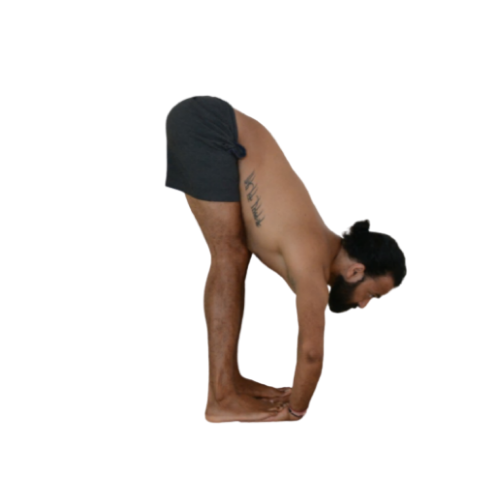From Sanskrit to English
Sanskrit pronunciation: Pada Hastasana (PAH-DAH-has-TAH-sah-nah)
Meaning: Pada = leg, foot ; hasta = hand
Known in English as Hands to Feet Pose, Pada Hastasana is a deeper version of Padangusthasana. Still a standing forward fold, it brings the opposite parts of our bodies together: upper and lower, hands and feet. This symbolizes the union of the higher and lower states of consciousness, the external nature and internal spirit – meant to balance the body and mind, preparing it for meditation.
Benefits of the pose
+ Stretches the back of the legs, hips, spine and wrists
+ Strengthens the legs
+ Increases blood circulation
+ Stimulates the kidneys, liver and abdominal muscles
+ Calms the mind and balances the nervous system
+ Improves digestion, concentration and flexibility
+ Relieves headaches, insomnia and menopause symptoms
Yoga for every BODY
Pada Hastasana is an intense body stretch. If you find it difficult to fold forward with your legs straight and/or can’t rest your forehead on your shins, keep working on Uttanasana and its modifications, Padangusthasana and its modification, or consider using the modification below.
Standard Pada Hastasana
From Tadasana:
1. Open your feet hip-distance apart and place your hands on your waist.
2. Press into the four corners of your feet, engage your legs, activate your mula bandha (root lock) and uddiyana bandha (abdominal lock).
3. Inhaling, lengthen your spine towards the sky, lifting your chest.
4. Exhaling, fold forward from the hip joint with your legs straight. As your torso descends, keep lengthening your spine and opening your front body to send your abdomen towards your thighs.
4. Turn the palms of your hands face up and slide them under the soles of your feet so that your toes are at the wrist joint.
5. Rest your forehead on your shins and draw your bent elbows open to the sides or slightly towards the front.
From Padangusthasana:
1. Inhale, look up and lengthen your spine. Release your big toes, turn the palms of your hands face up, and slide them under the soles of your feet so that your toes are at the wrist joint.
2. Exhale, fold forward and draw your bent elbows open to the sides or slightly towards the front.
Modification: Bend your knees & Look forward
Just like in Padangusthasana, bending your knees will help you focus on the lengthening of your front torso, preventing you from rounding your back and potentially compressing your neck. Looking forward will further enable you to keep your back straight.

Interested in becoming a yoga teacher?
Newsletter
Upcoming events and latest blogs